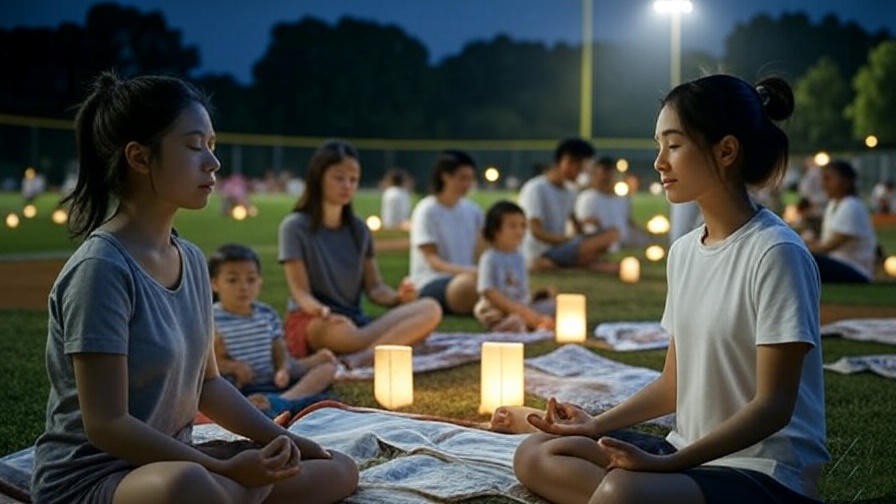Imagine stepping into a vibrant world where you control every detail—a dream park playground filled with lush forests, sparkling rivers, or even floating castles, all crafted by your imagination. This isn’t just a fantasy; it’s the power of lucid dreaming, a skill that lets you shape your dreams to enhance sleep, spark creativity, and boost holistic well-being. Many of us struggle with restless nights or feel disconnected from our inner creativity, but a dream park playground offers a solution. Backed by science and practical techniques, this article will guide you to create your own mental sanctuary, improving sleep quality and emotional health. Ready to unlock the magic of your dreams?
What Is a Dream Park Playground?

Defining the Concept
A dream park playground is a vivid, self-directed environment you create within a lucid dream—a dream where you’re aware you’re dreaming and can control the narrative. Picture it as a mental playground where you can fly through starlit skies, explore serene landscapes, or design fantastical adventures. Unlike regular dreams, where you’re a passive observer, a dream park playground empowers you to shape the experience, making it a powerful tool for relaxation, creativity, and self-discovery. This concept aligns perfectly with holistic wellness, blending mindfulness, imagination, and sleep optimization.
The Science Behind Lucid Dreaming
Lucid dreaming occurs during REM (Rapid Eye Movement) sleep, when the brain is highly active. Studies, such as those by Dr. Stephen LaBerge at the Lucidity Institute, show that lucid dreamers exhibit increased activity in the prefrontal cortex, the area responsible for decision-making and self-awareness. This heightened brain function allows you to “wake up” within your dream, giving you control. Research published in the Journal of Sleep Research (2018) suggests lucid dreaming can enhance neuroplasticity, helping the brain adapt and form new connections, which supports emotional regulation and creative problem-solving.
Why It Matters for Well-Being
A dream park playground isn’t just fun—it’s transformative. By controlling your dreams, you can reduce stress, process emotions, and even rehearse real-life scenarios. A 2020 study in Frontiers in Psychology found that lucid dreamers reported lower anxiety levels and improved mood, thanks to the sense of agency dreams provide. For those seeking holistic well-being, this practice fosters mindfulness, boosts creativity, and enhances sleep satisfaction, making it a cornerstone of mental and emotional health.
How a Dream Park Playground Enhances Sleep Quality
The Connection Between Lucid Dreaming and Sleep
Lucid dreaming strengthens your relationship with sleep by deepening REM cycles, where most dreaming occurs. According to a 2019 study in Sleep Medicine Reviews, lucid dreamers often experience more restorative sleep due to reduced sleep fragmentation. By creating a dream park playground, you engage with your dreams intentionally, which can stabilize sleep patterns and improve overall rest. This is especially valuable for those struggling with insomnia or irregular sleep schedules, as it transforms sleep into an active, empowering process.
Reducing Sleep Disruptions

Nightmares and sleep anxiety can disrupt rest, but a dream park playground offers a safe haven. By consciously shaping your dream environment, you can replace frightening scenarios with calming ones. For example, instead of a stressful chase, you might design a peaceful beach within your playground. Research from the International Journal of Dream Research (2021) shows that lucid dreaming reduces nightmare frequency by giving dreamers control, leading to fewer awakenings and better sleep continuity.
Practical Benefits for Daily Life
Better sleep translates to tangible benefits: sharper focus, improved productivity, and emotional resilience. Imagine waking up refreshed, with insights from your dream park playground fueling your day. For instance, a meditator named Sarah shared how her lucid dream park—a tranquil forest—helped her overcome insomnia by providing a mental escape from daily stress. These benefits align with holistic wellness, supporting mental clarity and happiness in everyday life.
Building Your Dream Park Playground: A Step-by-Step Guide
Step 1: Mastering Dream Recall
To create your dream park playground, start by remembering your dreams. Keep a dream journal beside your bed and write down every detail immediately upon waking—colors, emotions, settings. This trains your brain to retain dream memories. Tip: Use descriptive language, like “I walked through a glowing meadow,” to make recall vivid. Over time, you’ll notice patterns, which are key to lucid dreaming. Consistency is crucial—aim to journal daily for at least two weeks.
Step 2: Reality Checks for Lucid Dreaming
Reality checks help you recognize when you’re dreaming. Common techniques include:
- Reading text: In dreams, text often changes when you look away and back.
- Pinching your nose: If you can breathe while pinching, you’re dreaming.
- Checking hands: Hands may appear distorted in dreams.
Perform these checks 10–15 times daily to build the habit. For example, every time you walk through a door, pause to check if you’re dreaming. This practice, endorsed by Dr. LaBerge, primes your brain to question reality in dreams, sparking lucidity.
Step 3: Visualizing Your Playground
Before bed, visualize your dream park playground. It could be a serene lake, a bustling city, or a fantastical realm with floating islands. Use meditation techniques: close your eyes, breathe deeply, and imagine every detail—sights, sounds, textures. For instance, picture the rustle of leaves or the warmth of sunlight. This primes your subconscious to recreate the environment in your dreams. Start simple if visualization is hard, like imagining a single tree, and build complexity over time.
Step 4: Inducing Lucid Dreams
Two proven techniques for lucid dreaming are:
- Mnemonic Induction of Lucid Dreams (MILD): As you fall asleep, repeat, “I will know I’m dreaming.” Visualize your dream park while setting this intention.
- Wake-Initiated Lucid Dreams (WILD): Wake up after 5–6 hours of sleep, stay awake briefly (10 minutes), then return to sleep while focusing on your playground.
A beginner-friendly schedule: Practice MILD nightly and try WILD once a week. Research from Dreaming (2017) shows MILD is effective for 70% of beginners within a month.
Step 5: Maintaining Control in Your Dream Park
Once lucid, stabilize your dream to avoid waking up. Try:
- Rubbing your hands: This engages your senses, grounding you in the dream.
- Spinning in place: This can prolong lucidity by refocusing your brain.
- Engaging the environment: Touch objects or talk to dream characters.
In your dream park playground, experiment with activities like flying, creating art, or solving problems. For example, an architect used his dream park to design a building, later adapting it in real life. These techniques ensure your playground remains vivid and controllable.
The Holistic Benefits of a Dream Park Playground
Boosting Creativity and Problem-Solving
Lucid dreaming sparks creativity by allowing you to explore endless possibilities. A 2019 study in Dreaming found that lucid dreamers scored higher on divergent thinking tasks, which measure creative problem-solving. In your dream park playground, you can rehearse presentations, compose music, or brainstorm ideas. For instance, a writer named Alex used his dream park—a futuristic city—to draft novel scenes, unlocking ideas he couldn’t access while awake. This makes lucid dreaming a powerful tool for artists, entrepreneurs, and anyone seeking inspiration.
Emotional Healing and Stress Relief
Your dream park playground can serve as a therapeutic space. By confronting fears or processing emotions in a controlled environment, you can reduce stress. A 2020 study in Psychotherapy Research explored lucid dreaming for PTSD, finding that dreamers who reshaped traumatic scenarios experienced less distress. For example, someone afraid of public speaking might practice in their dream park, building confidence. This aligns with holistic wellness by fostering emotional resilience and inner peace.
Enhancing Mindfulness and Meditation
Lucid dreaming mirrors mindfulness by cultivating awareness and presence. In your dream park, you’re fully engaged, noticing every detail. This practice strengthens mindfulness skills, which carry into waking life. For instance, meditating on your dream park before bed can deepen your meditation practice, creating a feedback loop. Experts like Dr. Deirdre Barrett suggest integrating lucid dreaming with mindfulness for greater self-awareness, making it a natural fit for holistic well-being.
Expert Insights on Lucid Dreaming
What Experts Say
Renowned researchers like Dr. Stephen LaBerge, founder of the Lucidity Institute, emphasize that lucid dreaming is a learnable skill with profound benefits. In his book Lucid Dreaming: A Concise Guide to Awakening in Your Dreams and in Your Life, LaBerge explains how lucid dreaming enhances self-awareness and emotional regulation, making it a powerful tool for personal growth. Similarly, Dr. Deirdre Barrett, a Harvard psychologist, highlights in The Committee of Sleep that lucid dreams can unlock creative breakthroughs, citing examples like Paul McCartney composing melodies in dreams. Sleep specialists also note that lucid dreaming can improve sleep satisfaction by reducing nighttime stress, aligning perfectly with the concept of a dream park playground.
Common Myths Debunked
Despite its benefits, lucid dreaming faces misconceptions that can deter beginners. Let’s address the most common myths with evidence-based clarity:
- Myth: Lucid dreaming is dangerous. Research from the Journal of Sleep Research (2018) shows no evidence of harm; in fact, lucid dreaming can reduce nightmares and improve sleep quality.
- Myth: Only “gifted” people can lucid dream. Studies, including LaBerge’s work, confirm that anyone can learn with practice, typically within 1–3 months.
- Myth: Lucid dreaming disrupts sleep. When practiced correctly, lucid dreaming enhances REM sleep, leading to more restorative rest, as noted in Sleep Medicine Reviews (2019).
These clarifications build trust, ensuring readers feel confident exploring their dream park playground.
Safety and Best Practices
To maximize benefits and minimize risks, follow these guidelines:
- Balance practice with rest: Limit WILD attempts to once or twice weekly to avoid sleep disruption.
- Avoid forcing lucidity: Overtrying can lead to frustration or reduced sleep quality. Let progress happen naturally.
- Consult professionals if needed: For those with sleep disorders or mental health concerns, speak with a therapist before diving deep into lucid dreaming.
By adhering to these practices, you can safely create and enjoy your dream park playground, ensuring it supports your overall well-being.
Real-Life Success Stories
Case Study 1: Overcoming Anxiety
Meet Emma, a 32-year-old graphic designer who struggled with anxiety-induced insomnia. After learning lucid dreaming techniques, she created a dream park playground—a serene Japanese garden with koi ponds and cherry blossoms. By practicing reality checks and MILD, Emma began controlling her dreams within two months. In her playground, she confronted anxious thoughts, transforming them into calming visuals, like floating lanterns. Over time, her nighttime anxiety decreased, and she reported falling asleep faster and waking refreshed. Emma’s story shows how a dream park playground can be a sanctuary for emotional healing.
Case Study 2: Creative Breakthroughs
James, a 40-year-old musician, used his dream park playground to overcome writer’s block. His playground was a vibrant concert hall where he could experiment with melodies. Using WILD, James entered lucid dreams and “performed” new compositions, which he later transcribed upon waking. One dream-inspired song became a hit at his local gig, boosting his confidence. Research from Dreaming (2019) supports James’s experience, showing lucid dreaming enhances creative output. His story inspires artists to tap into their dream park for innovation.
Community Insights

Online communities like Reddit’s r/LucidDreaming offer valuable perspectives. Members share tips, like using specific scents (e.g., lavender) to enhance dream recall or practicing visualization during meditation. A common theme is accessibility—users of all ages and backgrounds report success with consistent practice. These real-world insights reinforce that anyone can build a dream park playground, making the practice relatable and achievable.
Tips for Sustaining Your Dream Park Playground Practice
Creating a Consistent Routine
To make lucid dreaming a habit, follow this nightly checklist:
- Journal dreams: Spend 5–10 minutes writing details each morning.
- Perform reality checks: Do 10–15 checks daily, like checking a clock or mirror.
- Visualize your playground: Spend 5 minutes before bed imagining your dream park.
- Set intentions: Repeat, “I will lucid dream tonight,” as you fall asleep.
Tools like the Awoken app or a Fitbit sleep tracker can support your routine by reminding you to journal or tracking REM cycles. Consistency is key—aim for 30 days to see results.
Overcoming Common Challenges
Newcomers often face hurdles, but solutions exist:
- Difficulty recalling dreams: Increase sleep duration or reduce screen time before bed to boost REM sleep.
- Losing lucidity: Stabilize dreams by engaging senses (e.g., touching objects) or spinning in the dream.
- Frustration with slow progress: Celebrate small wins, like vivid dreams, and adjust techniques (e.g., switch from MILD to WILD).
These strategies, backed by community feedback and research, keep you on track.
Integrating with Holistic Wellness

Your dream park playground complements other wellness practices:
- Meditation: Visualize your playground during mindfulness sessions to enhance dream vividness.
- Yoga: Practice relaxing poses like Child’s Pose before bed to calm the mind for lucid dreaming.
- Journaling: Combine dream journaling with gratitude journaling to boost positivity.
A sample weekly plan: Meditate 10 minutes daily, practice yoga twice weekly, and journal dreams every morning. This holistic approach amplifies the benefits of your dream park, fostering happiness and balance.
FAQs About Dream Park Playgrounds
Q: How long does it take to achieve lucid dreaming?
A: Studies, like those in Dreaming (2017), suggest 1–3 months with consistent practice (e.g., daily reality checks and MILD). Progress varies, but beginners often see results within weeks.
Q: Is lucid dreaming safe for everyone?
A: For most, yes. Research shows no major risks, but those with sleep disorders or severe mental health conditions should consult a doctor, as noted by the Lucidity Institute.
Q: Can a dream park playground help with specific mental health issues?
A: Yes, it can reduce anxiety or process trauma, as shown in Psychotherapy Research (2020). However, it’s not a substitute for therapy—consult professionals for serious issues.
Q: What if I can’t visualize my dream park?
A: Start with simple images, like a single flower, and build from there. Guided meditation apps or visualization exercises can help strengthen this skill.
Conclusion
A dream park playground is more than a whimsical escape—it’s a gateway to better sleep, enhanced creativity, and holistic well-being. By mastering lucid dreaming, you can craft a mental sanctuary that reduces stress, sparks inspiration, and transforms your relationship with sleep. Start tonight: keep a dream journal, practice reality checks, and visualize your playground. With patience, you’ll unlock a world where you control the narrative, boosting your emotional and mental health. Share your journey in the comments or on social media—your dream park awaits!













